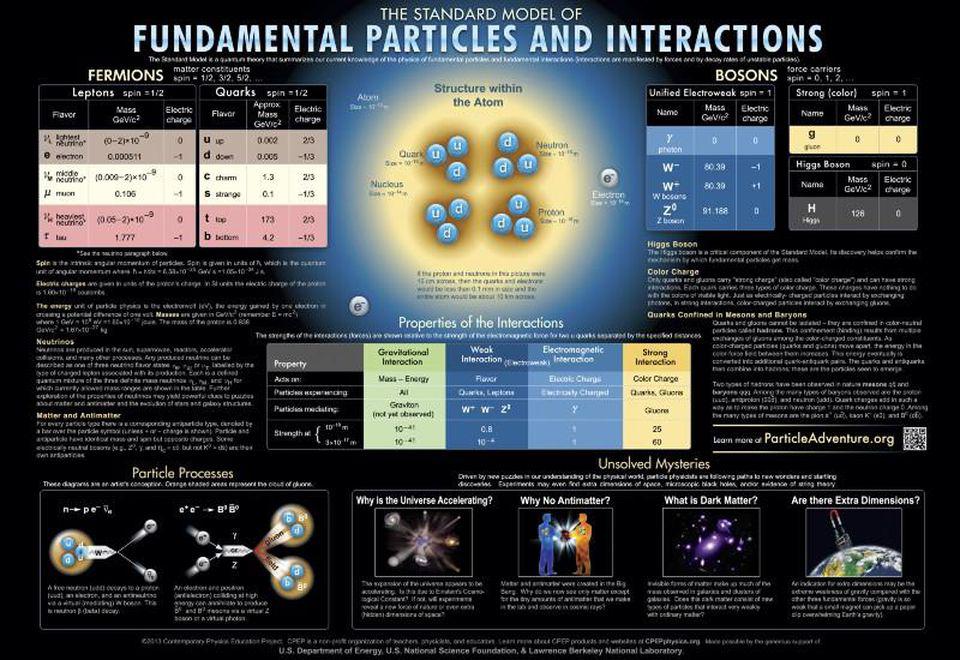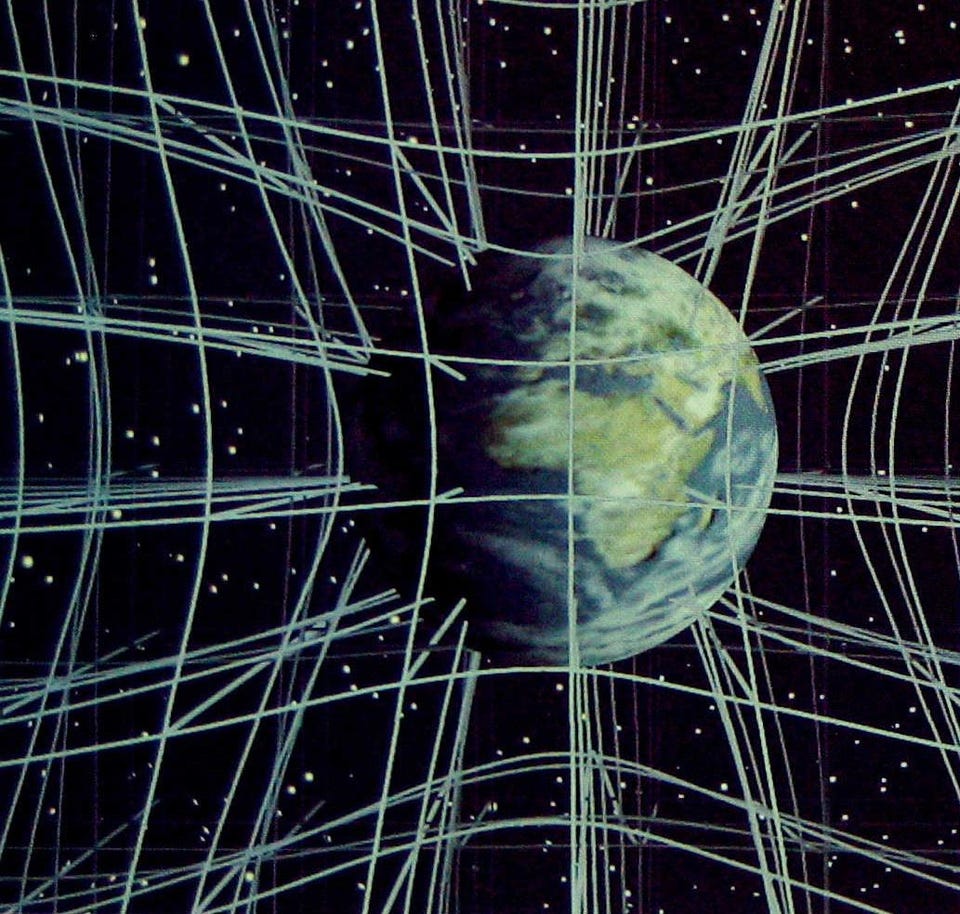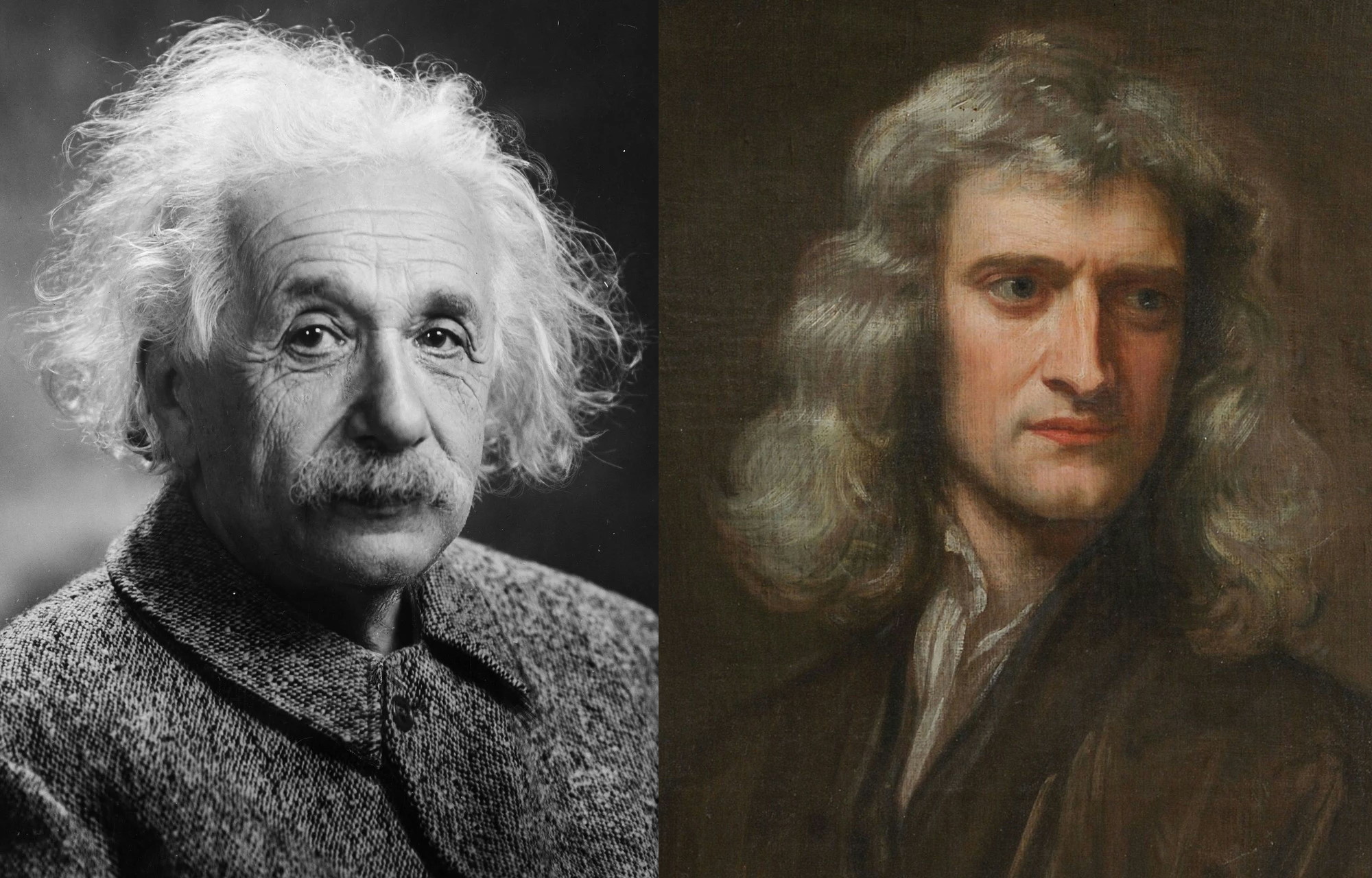How to prove Einstein’s relativity for under $100

- From all across the Universe, high-energy cosmic particles fly in all directions, including a few lucky ones that wind up striking planet Earth.
- When these particles, known as cosmic rays, strike our atmosphere, they produce cascades of new particles in events known as showers, including many that make it all the way to Earth's surface.
- A few of these particles, the muons, only live for 2.2 microseconds before decaying. But thanks to Einstein's relativity, they make it down to the surface and even hit your body. Here's how to see them for yourself.
As you stand on the surface of the Earth, what is it that you experience? Yes, the surrounding atoms and molecules of the atmosphere collide with your body, as do photons: particles of light. Some of these particles are particularly energetic, and can kick electrons off of the atoms and molecules they’re normally bound to, creating free electrons and ions that can strike you as well. There are ghostly neutrinos and antineutrinos passing through your body, although they rarely interact with you. But there’s more that you experience than you realize.
All throughout the Universe, from stars, black holes, galaxies, and more, cosmic rays are emitted: particles that stream through the Universe at high-energies. They strike Earth’s atmosphere and produce showers of both stable and unstable particles. The ones that live long enough before decaying eventually make their way down to Earth’s surface. Every second, somewhere between 10 and 100 muons — the unstable, heavy cousin of the electron — passes through your body. With a mean lifetime of 2.2 microseconds, you might think the ~100+ km journey to your hand would be impossible. Yet relativity makes it so, and the fact that these muons pass through your body are more than sufficient to prove it.

Individual, subatomic particles are almost always invisible to human eyes, as the wavelengths of light we can see are unaffected by particles passing through our bodies. But if you create a pure vapor made out of 100% alcohol, a charged particle passing through it will leave a trail that can be visually detected by even as primitive an instrument as the human eye. That’s right: with just a little bit of chemistry put to good use, your own human eye can serve as a particle detector.
As a charged particle moves through the alcohol vapor, it ionizes a path of alcohol particles, which act as centers for the condensation of alcohol droplets. The trail that results is both long enough and long-lasting enough that human eyes can see it, and the speed and curvature of the trail (if you apply a magnetic field) can even tell you what type of particle it was.
This principle was first applied in particle physics in the form of a cloud chamber.
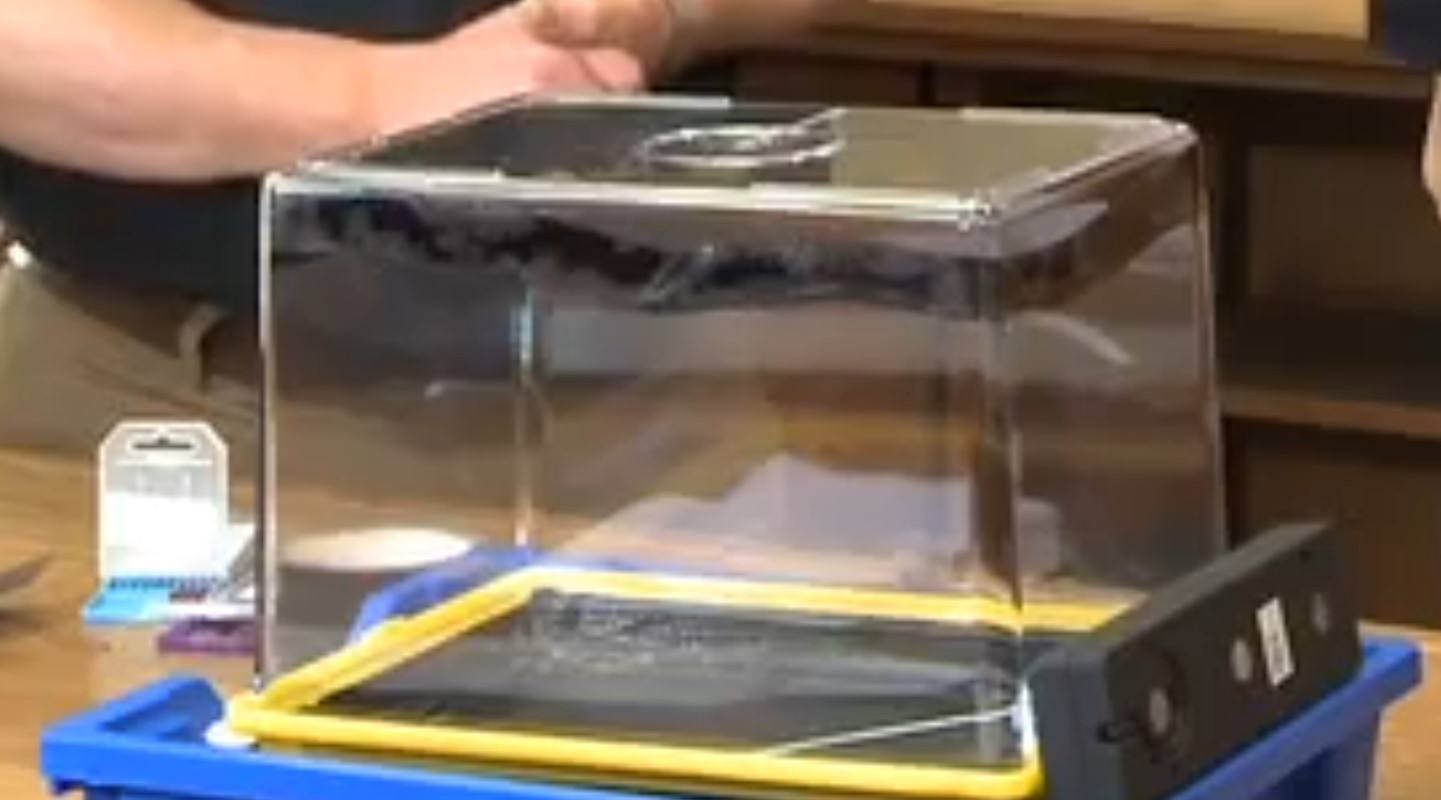
Today, a cloud chamber can be built, by anyone with commonly available parts, for a day’s worth of labor and less than $100 in parts. Particles moving through the atmosphere don’t make a visible trail, but particles moving through a 100% pure alcohol vapor do! Alcohol particles act as centers for condensation, and when a charged particle passes through an alcohol vapor (such as ethyl alcohol or isopropyl alcohol), it ionizes a path of those particles. This creates a trail that’s large enough and long-lasting enough for your eyes to easily pick out.
In general, the way you’ll want to go about building your own is as follows:
- Start by obtaining a rectangular aquarium fish tank, one that has good, solid seals around all the edges and will not leak.
- Cut three large pieces of thick, insulating foam of the same size: two with rectangular holes big enough to fit the fish tank inside, and one that remains solid to serve as your base.
- Cut a piece of galvanized steel sheet metal the same size as the insulating foam. Attach black card stock or matte black felt, or spray paint it with matte black paint, for the surface the size of the fish tank.
- Put the metal plate between the two top layers of insulating foam; add a two-sided layer of modeling clay for the tank to fit around. Add water or some of the alcohol solution into the groove so that when you put the tank atop it, no air can get in or out.
- Modify the fish tank by adding a layer of felt or sponge-like material to the tank’s base. Secure it good; it will be upside-down! Once that’s set, you’re ready to put it all together.
- Place some dry ice in the first two layers (solid base and hollow rectangle) of the insulating foam, then put the metal plate (black side up) atop that, then the last layer of insulating foam. Then put the water/alcohol into the clay groove, while simultaneously soaking/saturating the felt/sponge layer in the fishtank with the alcohol solution. (Pro tip: use more alcohol for saturating the felt/sponge layer than you think you ought to; don’t be stingy here!) Flip the fishtank over and put the edges inside the metal grooves, so that you have an airtight seal all around with the alcohol vapor inside.
- Turn off all the lights so it’s in a dark room, shine a bright flashlight (or projector) through the tank, place a warm, heavy object (like a folded towel, fresh out of the dryer) atop the tank, and wait about 10 minutes.
There are also some detailed guides around if you prefer more detailed instructions.
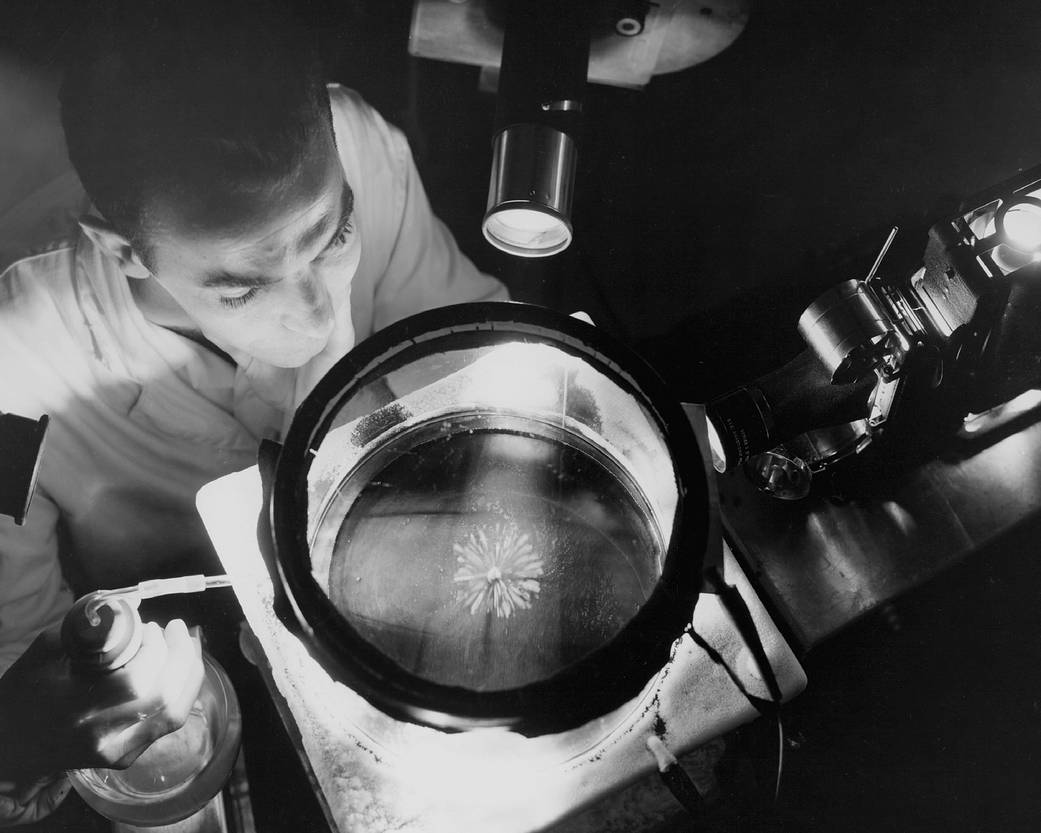
To make sure it’s working, I always recommend tearing apart an old smoke detector and removing the mantle: the metal component that warns you of its radioactive materials inside, typically an isotope of Americium. Because all isotopes of Americium decay, including the Americium-241 used in smoke detectors, they’ll emit particles that are capable of creating these ionization trails. Place this mantle on the bottom of your cloud chamber, once it’s active by following the steps above, you’ll see particles emanate from it in all directions, leaving tracks in your cloud chamber.
Americium, in particular, decays by emitting α-particles. In physics, α-particles are made up of two protons and two neutrons: they’re the same as a helium-4 nucleus. With the low energies of the decay and the high mass of the α-particles, these particles make slow, curved tracks and can even be occasionally seen bouncing off of the cloud chamber’s bottom. It’s an easy test to see if your cloud chamber is working properly.
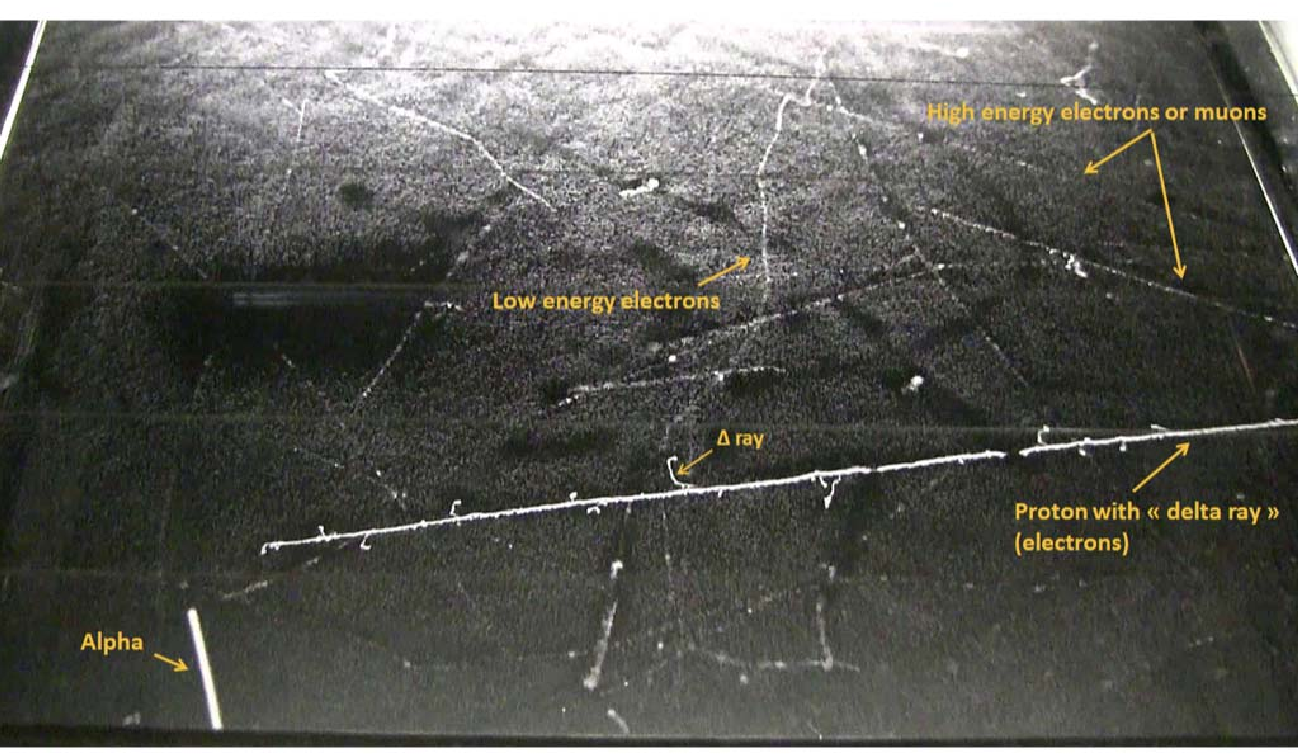
If you build a cloud chamber in precisely this fashion, however, those α-particle tracks aren’t the only things you’ll see. In fact, even if you leave the chamber completely evacuated (i.e., you don’t put a particle-emitting source of any type inside or nearby), you’ll still see tracks: they’ll be mostly vertical and appear as perfectly straight lines.
This isn’t because of radioactivity, but rather because of cosmic rays: high-energy particles that strike the top of Earth’s atmosphere, producing cascades of particles showering down from up high. Most of the cosmic rays that strike Earth’s atmosphere are composed of protons, but arrive moving with a wide variety of speeds and energies. The higher-energy particles will collide with particles in the upper atmosphere, producing particles like protons, electrons, and photons, but also unstable, short-lived particles like pions.
These particle showers are a hallmark of fixed-target particle physics experiments, and they occur naturally from cosmic rays, too.

Pions, made of a quark-antiquark combination, are unstable, and they come in three varieties:
- π+, a positively charged pion that lives for around 10 nanoseconds,
- π–, a negatively charged pion that also lives for around 10 nanoseconds,
- and π0, a neutral pion that lives for very short periods of time, only about 0.1 femtoseconds.
Although the neutral pions simply decay into two photons, the charged pions decay primarily into muons of the same charge (in addition to neutrinos/antineutrons). Muons are point particles, just like electrons, but have 206 times the electron’s mass and are, themselves, unstable.
Muons aren’t unstable in the same way as the composite pion, however. In fact, muons are the longest-lived unstable fundamental particle, as far as we know. Owing to their relatively small mass, they live for an astoundingly long 2.2 microseconds, on average.
If you were to ask how far a muon could travel once it was created, you might think to multiply its lifetime (2.2 microseconds) by the speed of light (300,000 km/s), which yields an answer of 660 meters. But that leads to a puzzle: why do you see them in your cloud chamber?
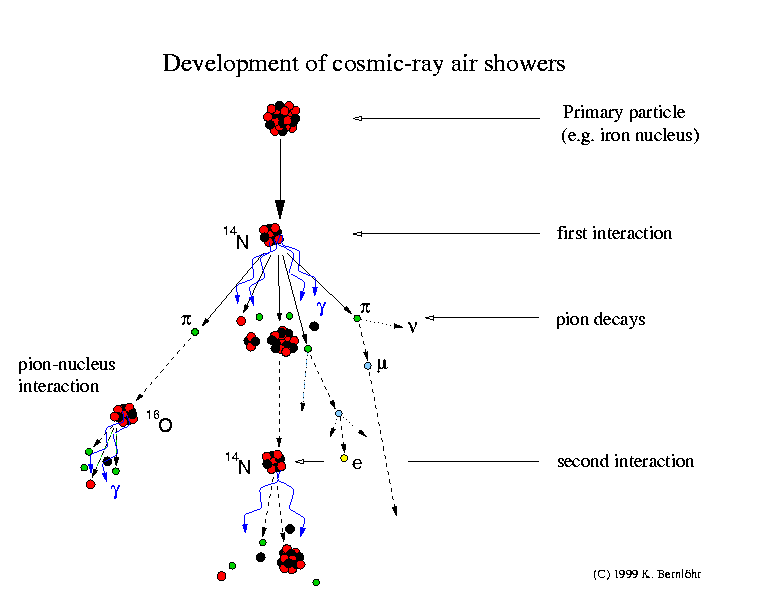
Earth’s atmosphere is more than 100 kilometers in height, and even though it’s very sparse at the highest elevations, it still has more than enough particles in it to ensure a quick interaction with any cosmic ray that comes in. These muons get created 100 kilometers away from Earth’s surface (or more) and have a mean lifetime of only 2.2 microseconds. Here’s the puzzle: if muons can only live for 2.2 microseconds, they’re limited by the speed of light, and they’re created in the upper atmosphere (around 100 km up), how is it possible for those muons to reach us down here on the Earth’s surface?
You might start to think of excuses. You might imagine that some of the cosmic rays have enough energy to continue cascading and producing particle showers during their entire journey to the ground, but that’s not the story the muons tell when we measure their energies: the lowest ones are still created some 30 km up. You might imagine that the 2.2 microseconds is just an average, and maybe the rare muons that live for 3 or 4 times that long will make it down. But when you do the math, only 1-in-1050 muons would survive down to Earth; in reality, nearly 100% of the created muons arrive.

How can we explain such a discrepancy? Sure, the muons are moving close to the speed of light, but we’re observing them from a reference frame where we’re stationary. We can measure the distance the muons travel, we can measure the time they live for, and even if we give them the benefit of the doubt and say that they’re moving at (rather than near) the speed of light, they shouldn’t even make it for 1 kilometer before decaying.
But this misses one of the key points of relativity!
Unstable particles don’t experience time as you, an external observer, measures it. They experience time according to their own onboard clocks, which will run slower the closer they move to the speed of light. Time dilates for them, which means that we will observe them living longer than 2.2 microseconds from our reference frame. The faster they move, the farther we’ll see them travel.
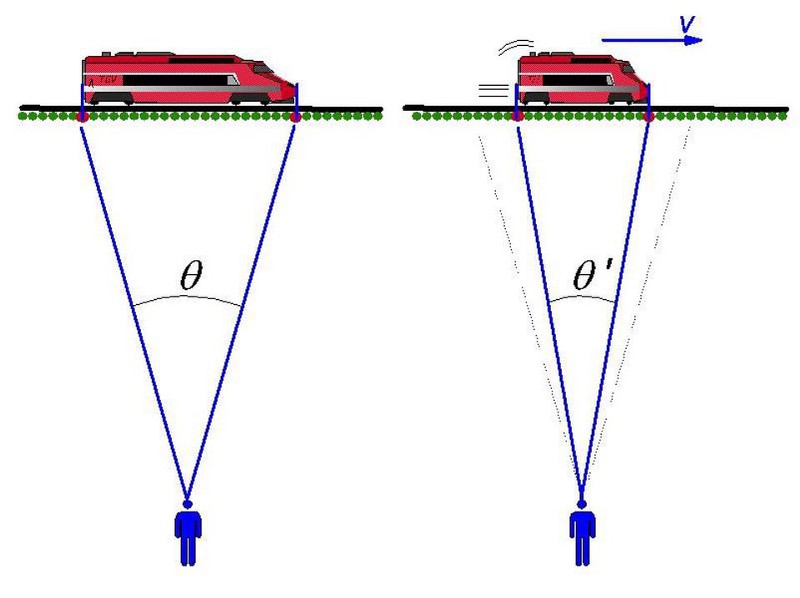
How does this work out for the muon?
From its reference frame, time passes normally, so it will only live for 2.2 microseconds according to its own internal clock. But it will experience reality as though it hurtles toward Earth’s surface extremely close to the speed of light, causing lengths to contract along its direction of motion. All of a sudden, it isn’t 100 kilometers it has to travel to Earth’s surface; it’s whatever that “proper distance” is contracted down by the Lorentz-FitzGerald contraction.
If a muon moves at 99.999% the speed of light, for example, every 660 meters outside of its reference frame will appear as though it’s just 3 meters in length: a reduction of its proper length by 99.5%. A journey of 100 km down to the surface would appear to be a journey of 450 meters in the muon’s reference frame. According to the muon’s clock, a muon created 100 kilometers up with this speed would experience only 1.5 microseconds of time passing. With that small amount of time experienced, there’s less than a 50/50 chance each muon will decay along that journey.
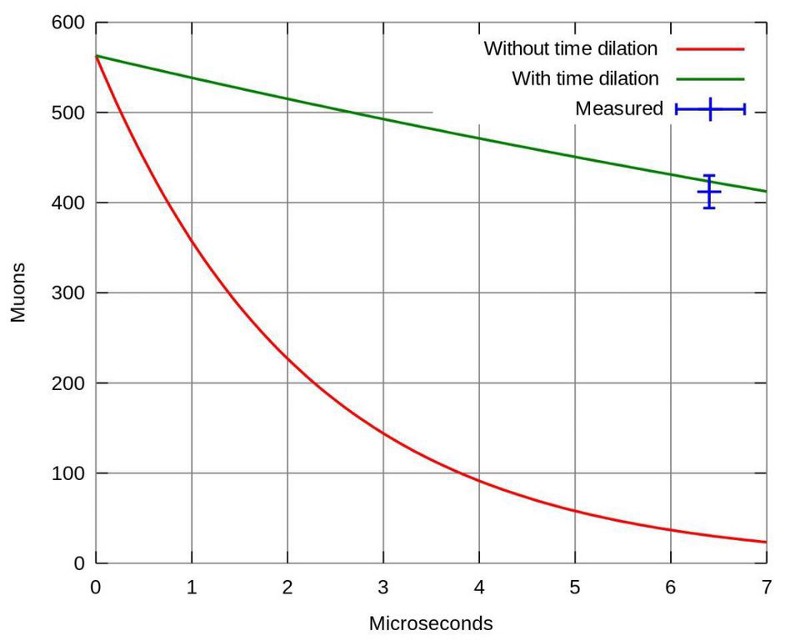
This teaches us how to reconcile things for the muon: from our reference frame here on Earth, we see the muon travel 100 km in a timespan of about 4.5 milliseconds. This isn’t a paradox, however, because the muon doesn’t experience 4.5 milliseconds; that’s how much time passes in our reference frame. According to the muon, the time it experiences is dilated relative to us, just as lengths are contracted relative to our lengths. The muon sees itself as traveling 450 meters in 1.5 microseconds, and hence it can remain alive all the way down to its destination of Earth’s surface.
Without the laws of Einstein’s relativity, this cannot be accounted for!
Within the context of relativity, however, high velocities correspond to high particle energies. The combined effects of time dilation and length contraction enable not just a few but most of the created muons to survive. This is why, even all the way down here at the surface of the Earth, between 10 and 100 muons pass through your body each second. In fact, if you hold out your hand and point it to the sky, approximately one muon per second passes just through that modest portion of your body.
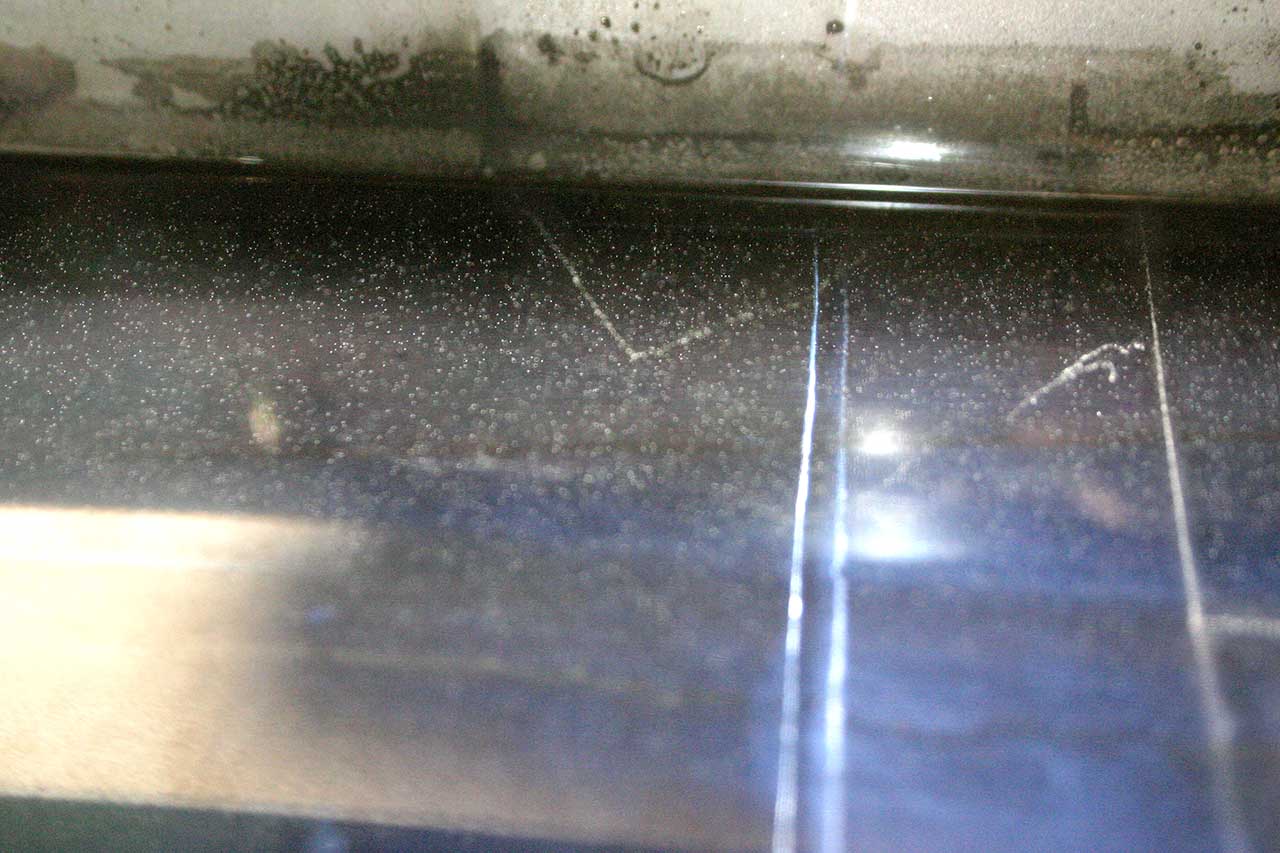
If you ever doubted relativity, it’s hard to fault you: the theory itself seems so counterintuitive, and its effects are thoroughly outside the realm of our everyday experience. But there is an experimental test you can perform at home, cheaply and with just a single day’s efforts, that allows you see the effects for yourself.
You can build a cloud chamber, and if you do, you will see those muons. If you installed a magnetic field, you’d see those muon tracks curve according to their charge-to-mass ratio: you’d immediately know they weren’t electrons. On rare occasion, you’d even see a muon decaying in mid-air. And, finally, if you measured their energies, you’d find that they were moving ultra-relativistically, at 99.999%+ the speed of light. If not for relativity, you wouldn’t see a single muon at all.
Time dilation and length contraction are real, and the fact that muons survive, from cosmic ray showers all the way down to Earth, prove it beyond a shadow of a doubt.
